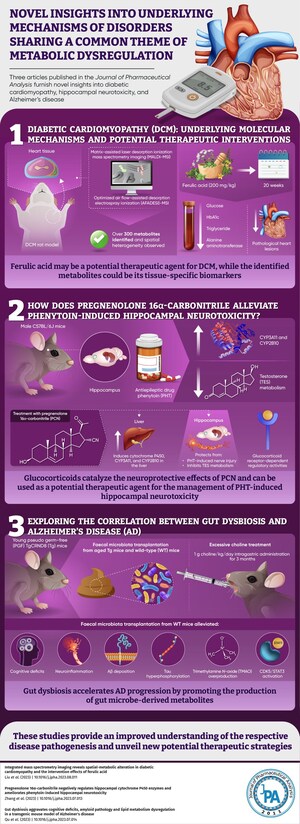New Journal of Pharmaceutical Analysis Articles Showcase Innovative Approaches for Diagnostics and Drug Screening and Evaluation
Recent research efforts put us one step closer to effective treatments for cancer and complex cardiovascular diseases
XI'AN, China, June 22, 2023 /PRNewswire/ -- Cancer and cardiovascular diseases (CVDs) continue to be two of the biggest challenges facing modern medicine. Developing better diagnostic procedures, as well as drug screening and assessment techniques, are crucial steps in the path to more effective treatments. The latest issue of the JPA features three articles on cutting-edge research in these directions.
The first study reports a novel non-invasive diagnostic tool to detect gastrointestinal tumors and was available online in February 2023 and published in Volume 13, Issue 4 of the journal in April 2023. This Good Manufacturing Practices-compliant probe is based on TST001, a man-made antibody that targets the protein CLDN18.2, which is overexpressed in various types of cancers. By labelling this antibody with radioactive zirconium, the researchers could quickly and non-invasively measure the expression of CLDN18.2 in both cancer cell lines and in vivo mouse models.
Currently, CLDN18.2 is measured using immunohistochemistry, which is invasive and limited in scope. This new approach, however, represents a great advantage over the conventional method. Talking about the potential applications of their research, author Hua Zhu, remarks, "With the increasing popularity of positron emission tomography and computed tomography equipment, we expect our probe to be used for screening patients with higher potential benefit from therapy, localizing systemic lesions, and evaluating the efficacy of novel drugs."
The second article by Cheng et al. discusses the pharmacological effects of two precious traditional Chinese medicinal herbs: Panax ginseng (PG) and Panax notoginseng (PN). The team developed a novel RNA sequencing-based, low-cost workflow called 'TCM-seq', which enabled them to simultaneously measure the effects of different doses of PG and PN components on multiple cell lines at the RNA or transcriptome level, greatly reducing experimental times and costs. Their findings indicated that saponins found in PG and PN may regulate genes involved in CVD and coagulation, respectively. "Our study proposes a new paradigm to comprehensively explore the differences in the mechanisms of action of Chinese medicines based on transcriptome readout," the corresponding author Xiaohui Fan remarks.
In the third study, researchers show how the mechanical and physiological properties of a cell can be useful for evaluating drug efficacy. To this end, they mechanically stimulated breast cancer and kidney cells, and developed a mathematical framework to record the change in their mechanical (viscosity and elasticity) properties in response to the drugs doxorubicin and paclitaxel. The technique can be used in cell cultures started form tumor samples at the single-cell level. According to the corresponding author Wenxue Wang, "Applying our approach for susceptibility testing before clinical chemotherapy will help improve the therapeutic effect of drugs and promote the advancement of personalized medicine".
Overall, these studies will pave the way to a deeper understanding of complex diseases like cancer and provide new techniques to discover, develop, and analyze the efficacy of treatments.
Reference
Title of original paper: Development of a CLDN18.2-targeting immuno-PET probe for non-invasive imaging in gastrointestinal tumors
Journal: Journal of Pharmaceutical Analysis
DOI: https://doi.org/10.1016/j.jpha.2023.02.011
Contact:
Mengjie Wang
+86-(0)29-82657423
[email protected]
SOURCE Journal of Pharmaceutical Analysis

WANT YOUR COMPANY'S NEWS FEATURED ON PRNEWSWIRE.COM?
Newsrooms &
Influencers
Digital Media
Outlets
Journalists
Opted In






Share this article